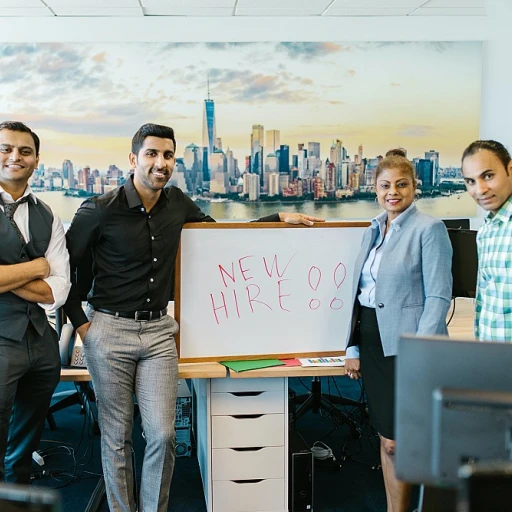
Understanding Strategic Thinking in Leadership
The Power of Strategic Thinking in Leading
Strategic thinking is no secret among successful leaders. It’s what fuels progress, shapes long-term goals, and drives an organization towards a promising future. But what exactly does it mean to think strategically in leadership? It’s more than just crafting a good plan; it's about developing a mindset that integrates critical thinking and visionary goals into practical strategies. Leaders armed with strategic thinking skills are game-changers. They read the environment, anticipate future trends, and navigate their team through the unpredictable waters of business management. These leaders recognize that strategic leadership is an ongoing process of setting long-term goals adjusted to short-term actions. Business scholars, like those at Harvard Business School, emphasize strategic thinking as a core skill of leadership development. Their teachings often highlight that strategic thinking is not just a skill to learn, but a full-on shift in mindset. It's about observing what others might miss, asking probing questions, and solving problems effectively. If you're a leader looking to sharpen your strategic edge, it starts with acknowledging that strategic thinking is a fundamental aspect of leadership training. This involves an intentional focus on improving strategic planning and gaining insights that lead to thoughtful decisions. As you develop your strategic mindset, you'll find that clear communication and team alignment become part of your natural leadership style. Engaging in exercises and development programs designed to enhance strategic thinking skills can be beneficial. These programs focus on nurturing one's ability to make informed decisions, develop strategic plans, and foster innovation within the organization. In your leadership journey, having a toolbox of strategic skills could set you apart from others in the world of management. To master goal-setting and strategy in leadership, check out this guide on mastering goal setting for leadership growth. Whether you're in a boardroom, on the field, or leading a remote team, embracing strategic thinking could be the catalyst your leadership needs.The Role of Vision in Strategic Leadership
The Power of Forward-Looking Vision
When it comes to strategic leadership, having a clear vision acts like a guiding star for leaders. It helps set a direction and motivates a team. A worthwhile vision serves as a long term objective, igniting passion and empowering colleagues across all levels to stretch beyond their limits. This is where thinking skills play a vital role. Leaders must be adept at painting vivid pictures of the future, allowing their team to dream big and imagine their business years ahead. Being a strategic leader involves crafting a compelling vision, much like a top plot in a memorable movie plot. The vision should not only align with the goals of the organization but also challenge and inspire. For leaders, learning how to creatively share their visions can be a critical step in their development. But let’s not forget the gritty details. While high-level ideas are exciting, visions require careful planning and execution. Strategic thinkers break down these visions into achievable stages, creating bite-sized goals that, when met, lead the team closer to the ultimate prize. A few pointers for developing a vision include:- Be Clear: Clarity is king. Make sure everyone knows what they’re heading towards.
- Involve the Team: A shared vision is a stronger vision. Ask for input.
- Communicate Effectively: Share the vision across all platforms consistently.
- Stay Flexible: Be open to revising the vision as necessary.
Nurturing Strategic Thinking Skills
Developing strategic thinking is an art built on critical thinking and problem solving. Just like art, it requires practice and patience. Leaders need to actively train their minds to think ahead, weigh options, and foresee challenges. Participating in development programs, such as workshops or courses, can be a great way to hone these skills, tailoring them to fit within any business framework. Enabling a strategic mindset involves regularly stepping back and assessing the bigger picture. Sharing strategic thinking with the team ensures everyone is on the same page so that when making decisions, they're made with a full understanding of the underlying strategy and its implications. Some ways to develop these skills include:- Engage in Brainstorming Sessions: Pool thinking power within the team for more creative solutions.
- Play the "What If" Game: Challenge the team with scenarios to explore possibilities and prepare for contingencies.
- Read Widely and Diversely: Staying informed on industry trends and general world trends sharpens perspective.
Emphasizing Strategic Decision-Making
Getting to grips with decision making that's strategically oriented can sometimes feel like solving a complex puzzle. Successful leaders understand the value in weighing possibilities, anticipating outcomes, and aligning decisions with their vision and goals. Decision making, when done strategically, involves careful evaluation of all available resources, both human and financial, to ensure that decisions are sustainable and beneficial long term. Strategic leaders often employ a blend of data, intuition, and team input. They direct their decisions by:- Collecting Relevant Information: Gathering data from reliable sources to better understand the context of their decisions.
- Using a Balanced Approach: Considering both analytical data and intuitive insights before finalizing decisions.
- Involving the Team: Crowdsourcing ideas and feedback to make more informed choices.
Developing Strategic Thinking Skills
Building a Strategic Mindset for Leadership Success
Understanding strategic thinking in the context of leadership development isn't just theory—it's about preparing leaders to pave the way to success. At Harvard Business School, seasoned educators emphasize the value of instilling a strategic mindset as foundational. So, how do leaders truly develop such invaluable skills? Critical Thinking Insights Strategic leaders often excel in critical thinking. It's not some mystical talent, but a skill that can be honed through conscious effort. Leaders, by practicing reflective thinking and stress-testing their assumptions, learn to question their thought processes and consider different perspectives. Business schools around the world have tailored programs to challenge students with real-world scenarios, fostering this analytical prowess. Long-Term Goals and Planning In business, thinking long term is non-negotiable. Leaders need to anticipate future challenges and opportunities within the organization. Strategic planning sessions are a great place to start. By aligning their team's efforts towards shared, ambitious goals, leaders can cultivate a forward-thinking culture. Problem Solving and Decision Making We all know decision making can be daunting, especially when caught in the whirlwind of a fast-paced business environment. Leaders sharpen their problem solving skills through rigorous training and experience. For more insights on streamlining this process, you might want to explore mastering leadership through effective problem solving for detailed strategies. Investing in Continuous Growth To remain competitive, leaders must keep abreast of the latest management trends. Development programs can provide valuable resources and coaching, helping leaders align their approach to the shifting expectations of the modern business world. Business coaching is an investment that pays dividends by sharpening one's strategic mindset. The essentials of cultivating a strategic mindset in leadership involve a blend of consistent practice, openness to learning, and the courage to make informed decisions. Leaders who embody these traits can unlock their potential and steer their teams towards long term success.Strategic Decision-Making Processes
Making Smart Choices: The Heart of Strategic Leadership
Strategic decision-making is at the core of effective leadership. When leaders have a clear vision, they can steer their teams and organizations toward success. But making smart choices isn't just about having a plan; it's about understanding the bigger picture and being prepared to adapt when needed. Harvard Business School emphasizes that strategic thinkers are those who can weigh options, foresee potential outcomes, and choose paths that align with long-term goals.
Building a Strategic Mindset
Developing a strategic mindset requires more than just training; it involves a shift in how leaders approach problems. It's about honing critical thinking skills and learning to anticipate future challenges. Leaders who excel in strategic thinking often engage in continuous learning and development programs. They know that the business environment is ever-changing, and staying ahead means constantly refining their skills.
Team Collaboration and Strategic Planning
Effective strategic leaders understand the value of collaboration. They bring their teams into the decision-making process, ensuring that diverse perspectives are considered. This not only enriches the strategy but also fosters a sense of ownership among team members. According to experts in leadership development, successful leaders create an environment where open communication and shared goals drive the strategy forward.
Resources and Time Management
Strategic decision-making also involves smart resource allocation and time management. Leaders must prioritize tasks that align with their strategic goals, ensuring that resources are used efficiently. This requires a keen understanding of the organization's capabilities and a commitment to optimizing performance. By focusing on long-term objectives, leaders can make informed decisions that benefit the organization in the future.
Coaching and Development for Strategic Leaders
Coaching plays a vital role in developing strategic leaders. Through personalized guidance, leaders can refine their decision-making skills and gain insights into effective strategy implementation. Many organizations invest in leadership development programs to nurture their leaders' strategic thinking abilities. These programs often include real-world scenarios and problem-solving exercises that challenge leaders to think strategically.
Overcoming Barriers to Strategic Thinking
Breaking Through Barriers with Strategic Prowess
One of the biggest challenges any leader confronts is the ability to think strategically amidst hurdles. But don’t worry, breaking through these barriers isn't just for the natural-born strategists—it’s for you too! You see, strategic leaders aren’t born, they are made through consistent practice, focus, and clear understanding of their goals. Let’s face it, even with the sharpest strategic mindset, roadblocks are inevitable. But how do we turn stumbling blocks into stepping stones?- Mindset Shift: Often, barriers stem from the way we think. Training your mind to see obstacles as opportunities instead of threats can create a ripple effect on the overall strategic decision-making process. Embrace critical thinking to develop new problem-solving skills.
- Resource Allocation: No strategy can be executed without the right resources. Whether it's the team behind you or the tools at your disposal, efficient resource management is key. Leaders need to ensure that both available and future resources align with their long-term strategy.
- Team Dynamics: A united team can conquer mountains. Building a team that believes in the strategy leads to better cooperation and innovative solutions. Leadership development often involves coaching peers and fostering an inclusive environment to achieve shared goals.
- Skill Enhancement: Through leadership development programs, leaders can refine necessary thinking skills. Engaging in continuous business training and management workshops can help develop strategic thinking and improve decision-making abilities.
- Time Management: Often, barriers seem insurmountable due to time constraints. However, skillful time management allows leaders to strategically plan for short-term actions while staying focused on long-term goals.












